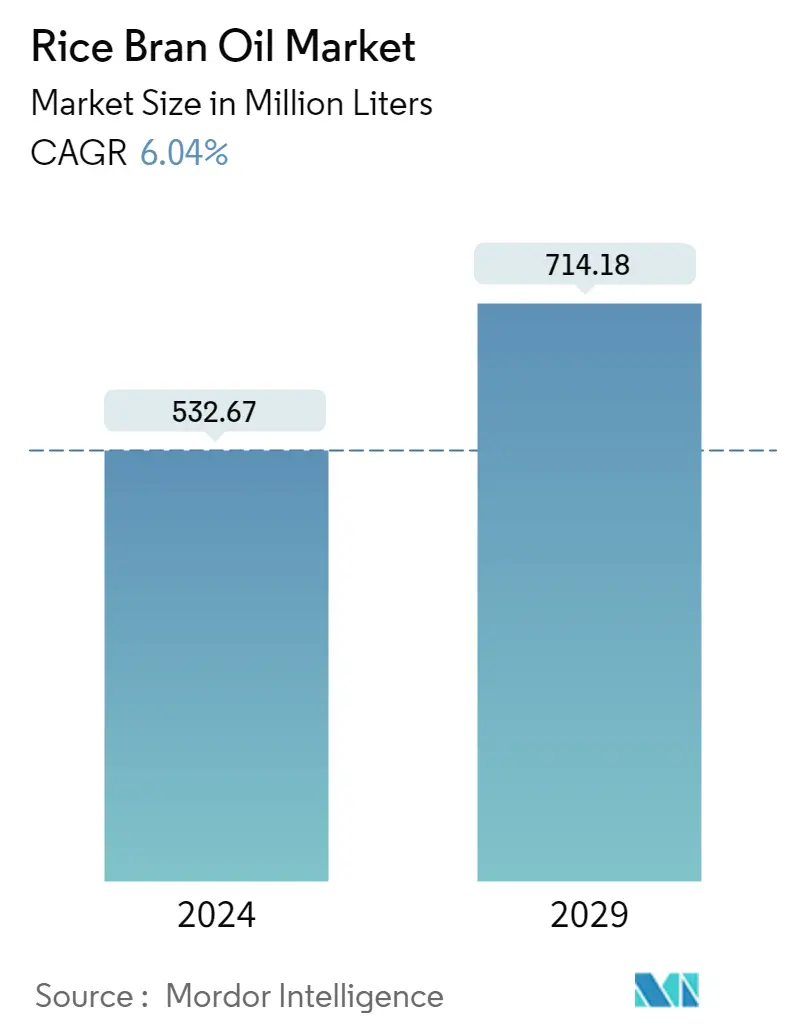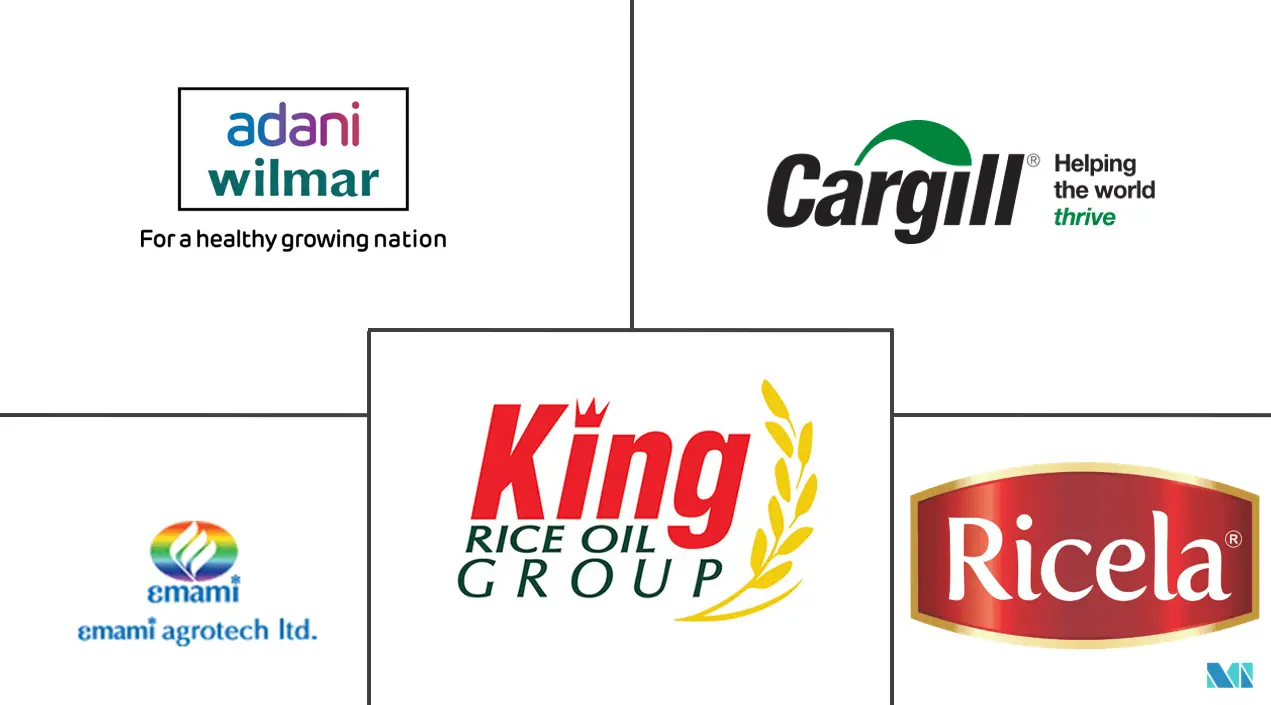Market Size of Rice Bran Oil Industry

| Study Period | 2018 - 2029 |
| Base Year For Estimation | 2023 |
| CAGR (2024 - 2029) | 6.04 % |
| Fastest Growing Market | Europe |
| Largest Market | Asia Pacific |
| Market Concentration | Low |
Major Players
*Disclaimer: Major Players sorted in no particular order |
Rice Bran Oil Market Analysis
The Rice Bran Oil Market size is estimated at 532.67 Million liters in 2024, and is expected to reach 714.18 Million liters by 2029, growing at a CAGR of 6.04% during the forecast period (2024-2029).
The rice bran oil market is driven by rising consumer health consciousness and high demand for nutritional and fat-free food and beverages owing to its mild flavor, neutral taste, and rich nutrient content. Rice bran oil is extensively used in culinary activities across most Asia-Pacific cuisine. These factors propel the sales of edible oils in the market. For instance, According to Agriculture and Afri Food Canada, the retail sales value of edible oils in China is estimated to be USD 15.48 million in 2021. In recent times, organic rice bran oil has gained popularity among retail consumers as it comes with no artificially added ingredients and imparts a natural taste to the recipe. Other factors responsible for the market's growth include numerous application areas, aggressive promotional campaigns by manufacturers, and high penetration in developed and emerging markets.
Regulatory bodies favoring the consumption of rice bran oil have further boosted the market growth. For instance, the World Health Organization (WHO) and the American Heart Association have approved the use of rice bran oil, stating that its monounsaturated, polyunsaturated, and saturated fats composition is much safer than the composition of most other vegetable oils. These regulation has facilitated the manufacturers in the market to increase their offerings in the retail market to attract consumers. Supermarkets/hypermarkets and convenience stores play an essential role in the distribution of rice bran oil, as they are extensively retailed in these retail establishments, which the consumers frequently visit in the market.
Rice Bran Oil Industry Segmentation
Rice bran oil is prepared by extracting oil from the chaff of the rice. This oil has a high smoke point, making it useful for cooking at high temperatures and a very mild flavor. The rice bran oil market is segmented by category, distribution channel, and geography. By category, the market is segmented into organic and conventional. Based on the distribution channel, the market is segmented into hypermarkets/supermarkets, convenience stores, online retail stores, and other distribution channels. By geography, the market is segmented into North America, Europe, Asia-Pacific, South America, the Middle East, and Africa. For each segment, the market sizing and forecasts have been done based on value (in USD million).
| Category | |
| Organic | |
| Conventional |
| Distribution Channel | |
| Supermarket/Hypermarket | |
| Convenience Stores | |
| Online Retail Stores | |
| Other Distribution Channels |
| Geography | ||||||||
| ||||||||
| ||||||||
| ||||||||
| ||||||||
|
Rice Bran Oil Market Size Summary
The rice bran oil market is experiencing significant growth, driven by increasing consumer awareness of health benefits and a rising demand for nutritional and fat-free food options. Its mild flavor and rich nutrient content make it a popular choice in culinary applications, particularly in Asia-Pacific cuisines. The market is further bolstered by the growing popularity of organic rice bran oil, which appeals to consumers seeking natural ingredients. Regulatory endorsements from organizations like the World Health Organization and the American Heart Association have also contributed to the market's expansion, as they highlight the health advantages of rice bran oil compared to other vegetable oils. The market's growth is supported by the increasing production of rice globally, with major producers such as China, India, and Indonesia leading the way. This rise in rice production has enhanced the availability of rice bran oil, further driving market demand.
Asia-Pacific holds a substantial share of the rice bran oil market, with India, China, Japan, and Thailand being key players due to the easy access to raw materials. The region's market is expected to grow significantly, fueled by the perceived health benefits of rice bran oil, such as cholesterol reduction and heart health improvement. The market is highly competitive and fragmented, with numerous small and regional players alongside major companies like Cargill, Incorporated, and Adani Wilmar Ltd. These companies are focusing on strategic initiatives such as mergers, acquisitions, and new product developments to strengthen their market presence. The introduction of fortified rice bran oil in India and the relaunch of brands like Healthy & Tasty by Emami Agrotech Limited are examples of efforts to enhance brand visibility and consumer awareness.
Rice Bran Oil Market Size - Table of Contents
-
1. MARKET DYNAMICS
-
1.1 Market Drivers
-
1.2 Market Restraints
-
1.3 Porter's Five Forces Analysis
-
1.3.1 Threat of New Entrants
-
1.3.2 Bargaining Power of Buyers/Consumers
-
1.3.3 Bargaining Power of Suppliers
-
1.3.4 Threat of Substitute Products
-
1.3.5 Intensity of Competitive Rivalry
-
-
-
2. MARKET SEGMENTATION
-
2.1 Category
-
2.1.1 Organic
-
2.1.2 Conventional
-
-
2.2 Distribution Channel
-
2.2.1 Supermarket/Hypermarket
-
2.2.2 Convenience Stores
-
2.2.3 Online Retail Stores
-
2.2.4 Other Distribution Channels
-
-
2.3 Geography
-
2.3.1 North America
-
2.3.1.1 United States
-
2.3.1.2 Canada
-
2.3.1.3 Mexico
-
2.3.1.4 Rest of North America
-
-
2.3.2 Europe
-
2.3.2.1 Spain
-
2.3.2.2 United Kingdom
-
2.3.2.3 Germany
-
2.3.2.4 France
-
2.3.2.5 Italy
-
2.3.2.6 Rest of Europe
-
-
2.3.3 Asia-Pacific
-
2.3.3.1 China
-
2.3.3.2 Japan
-
2.3.3.3 India
-
2.3.3.4 Australia
-
2.3.3.5 Rest of Asia-Pacific
-
-
2.3.4 South America
-
2.3.4.1 Brazil
-
2.3.4.2 Argentina
-
2.3.4.3 Rest of South America
-
-
2.3.5 Middle-East and Africa
-
2.3.5.1 South Africa
-
2.3.5.2 Saudi Arabia
-
2.3.5.3 Rest of Middle-East and Africa
-
-
-
Rice Bran Oil Market Size FAQs
How big is the Rice Bran Oil Market?
The Rice Bran Oil Market size is expected to reach 532.67 million liters in 2024 and grow at a CAGR of 6.04% to reach 714.18 million liters by 2029.
What is the current Rice Bran Oil Market size?
In 2024, the Rice Bran Oil Market size is expected to reach 532.67 million liters.

